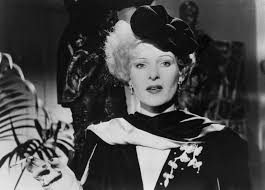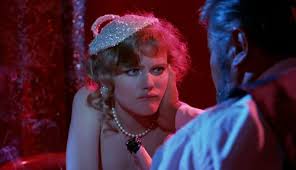STUDIO: Criterion | DIRECTOR: Rainer Werner Fassbinder | CAST: Hanna Schygulla, Klaus Löwitsch, Rosel Zech, Barbara Sukowa, Armin Mueller-Stahl
RELEASE DATE: 7/9/19 | PRICE: Blu-ray $49.99
BONUSES: Audio commentaries featuring Wim Wenders and cinematographer Michael Ballhaus, film critic Tony Rayns, and film scholar Christian Braad Thomsen; interviews with actors Hanna Schygulla, Rosel Zech, Barbara Sukowa, cinematographer Xaver Schwarzenberger, screenwriter Peter Märthesheimer, and film scholar Eric Rentschler; a 1978 interview with Fassbinder; 1992 documentary I Don’t Just Want You to Love Me; a 2000 doc actress Sybille Schmitz; and a conversation between curator Laurence Kardish and editor Juliane Lorenz
SPECS: NR | 339 min. | Foreign language drama | 1:66 (The Marriage of Maria Braun/Lola)/1:78 (Veronika Voss) | mono | German with Engilsh subtitles
Rainer Werner Fassbinder’s 13-year torrent of brilliant motion pictures was capped by two of the three sublime films in this set. (The first was done before a final burst of insane creative energy that spawned the 15-hour Berlin Alexanderplatz.) This remastered Blu-ray re-release of the out-of-print DVD box reminds us just how impressive was his melding of modernist techniques and tropes from classic Hollywood melodramas.
Fassbinder’s discovery in the winter of 1970-71 of the work of Douglas Sirk (All That Heaven Allows) led to a series of radically different dramas that fused political concerns with dense visuals, intense performances from his stock company of performers, and an ironic revision of the codes of the “woman’s picture” and other standard Hollywood genres. All of his films are compulsively watchable, even the most obscure (Satan’s Brew) and grimly depressing (In a Year of 13 Moons).
The BRD Trilogy (“BRD” being the abbreviation for the official German title for West Germany) was Fassbinder’s effort to sketch the post-war period of Germany’s “economic miracle” in chronological fashion through three unrelated stories of women who ultimately face a decision to stay within a corrupt milieu or try to escape it. Only one character appears in all three films: an American soldier, played by Fassbinder stalwart Gunther Kaufman (The Bitter Tears of Petra von Kant), who dwells in the background of the action.
The Marriage of Maria Braun (1978), the first film in the set, was the first Fassbinder film that became a major arthouse hit in the U.S. This was perhaps attributable to the familiar “downtrodden woman takes control of her own life” plot and healthy doses of sexuality and dark humor – or the movie poster, which showed star Hanna Schygulla (Love Is Colder Than Death) in lingerie and garters.
The film calls to mind countless Hollywood films, but Fassbinder’s deftly composed visuals and the extremely “busy” soundtrack – where radio broadcasts and the sounds of jackhammers sometimes compete with the dialogue – perfectly underscore the plot. A war bride (Schygulla) uses men to advance her career but remains dutifully tied to her family and her one true love, her husband, who is initially thought to be dead but then returns at a classically inopportune time (when she is preparing to have sex).
One of the dominant aspects of the trilogy is that each female lead character has traces of the persona of Marlene Dietrich. Schygulla is costumed like Dietrich in Maria Braun (but “became” Marlene for Fassbinder in the 1980 fictional narrative Lili Marleen, never available on DVD or even VHS in America). In Veronika Voss (1981), Rosel Zech is a German movie star of Marlene’s vintage (but whose personal vices have turned her into a has-been), and in the final film in the trilogy, Lola (1981), Barbara Sukowa (Gloria Bell) plays a modern, more sympathetic take on Dietrich’s Lola Lola character in The Blue Angel.
Veronika Voss is arguably the tightest and most deftly scripted of the three films, as its B&W visuals are gorgeous and the plotline is a clever variant on Sunset Boulevard. Although it was shot and released after Lola for the sake of schedules and budgets, Veronika Voss is a perfect “midpoint” to the trilogy, as it is the most despairing of the three films and is also a B&W interlude in the middle of two films that communicate much of their emotion through their color schemes.
The emotion in Veronika is hidden in the stark white backgrounds, pitch-black areas, shadow patterns and tongue-in-cheek transitions (including every conceivable “wipe”). The plot concerns a sports reporter/aspiring poet (Hilmar Thate) who becomes fascinated by a faded movie star (Rosel Zech), currently living as a drug addict in thrall to a cruel doctor (Annemarie Düringer).
The last film, Lola, is a brilliant creation, a saga of small-town corruption that is “color-coded” to convey the nature of the characters, the sacred and profane spaces they inhabit and, most importantly, the moral dilemma facing the main character. The lead character is a town planner (Armin Mueller-Stahl, Attack on Leningrad) whose attraction to a chanteuse/hooker (Sukowa) threatens his rigid code of ethics.
Watching the trilogy in a row, one is struck not only by the sumptuous visuals crafted by Fassbinder and cinematographers Michael Ballhaus (The Last Temptation of Christ) and Xaver Schwarzenberger, but also the way that RWF – deemed a “cold,” calculating filmmaker by some critics – openly displayed his evident sympathy for his characters (even the smallest of them).
The stark blacks and whites of Veronica Voss make it a challenge for restoration; here, certain scenes contain digital film grain, where others are crisp and compelling. The new, gorgeous restorations of Maria Braun and Lola are a marked improvement over the previous DVD releases. The supplements in the set are the same from the 2003 DVD box; a few stand out as being exceptionally informative.
Cinematographer Michael Ballhaus and Fassbinder’s colleague in the New German Cinema movement, Wim Wenders (The American Friend), supplied an audio commentary for Maria Braun in 2003. As could be expected, Ballhaus provides technical info about the film, including the fact that the color was muted during the opening sequences (when Germany was in the post-war doldrums) and becomes sharper and brighter as the film moves on (as Germany and the lead character both experience the “economic miracle”).
For his part, Wenders offers information about the atmosphere in post-war Germany and comments on the New German Cinema, which he declares “had no common aesthetics… no common program” but was “linked by an act of solidarity” (the 1970 founding by Fassbinder, Wenders and other filmmakers of the independent distribution company Filmverlag der Autoren). He also declares Maria Braun to be “the best” film by his late friend.
Hanna Schygulla talks about Fassbinder and Maria Braun in an onscreen interview from 2003. From a remove of two decades, she calmly reflects on the fact that she liked working with RWF but was very frustrated by his casting her as empty, male-dependent characters, saying she felt like his “play-doll.”
She then discusses the four-year break in her friendship with Fassbinder, and how Maria Braun was his peace offering to her. While she felt that the script was riddled with cliches (from old Hollywood to classic Brechtian elements), she acknowledges that it was her breakthrough role in film and contained a key moment for her – Fassbinder, acting as a black-market salesman, kisses her hand and wishes her good luck.
A 48-minute interview with Fassbinder for German TV remains the most eye-opening inclusion in the collection. Shot in 1978 (while he was preparing Maria Braun), the conversation with film scholar Peter W. Jansen functions like a therapy session, with a chain-smoking, coffee-drinking RWF answering intimate questions about his life and work. (“Are you capable of living with another person?”)
He discusses his early life in detail, talking about “a childhood that didn’t happen,” and the fact that he became the leader of a theater troupe, and later cinematic ensemble, that he put together. He denies ever wanting to run the group but does admit “it was the role I was supposed to play.”
While Schygulla openly maintains in the 2003 interview that Fassbinder openly depicted love as “submission,” he himself seems hesitant in the 1978 interview to sum up his major theme, but then eventually states that “it has to do with the fact that the one who loves less has more power.” As for the fact that he was a compulsively prolific artist, his only answer is to say that “it must be a special kind of mental illness… I don’t know.”
The 1992 documentary I Don’t Just Want You to Love Me offers both a good “101” for those new to Fassbinder’s work and some new details for diehard fans. Filmmaker Hans Gunther Pflaum interviews a host of RWF’s crew and cast members, plus his mother and the occasional producer. While a good deal about his life is discussed – including the fact that he and his contemporaries viewed their parents’ generation as monsters of a kind – the documentary concentrates on his work. It is most fascinating to hear from all three of his cinematographers and the composer of his scores, Peer Raben (a solid amount of the emotion in Fassbinder’s work comes from Raben’s evocative scores).
We learn from the documentary and some of the other onscreen extras in this collection a fact that makes the high quality of Fassbinder’s films even more impressive – that he expected cast and crew to give their best on the first take, and thus his later films (including the three found here) are predominantly assemblages of first takes.
Karlheinz Böhm (Fox and His Friends) gives us the best indication of RWF’s place as an essential social critic when he talks about the time he read a script by Fassbinder that openly mocked the German Communist party. Böhm noted that RWF had drubbed both Right and Left in his films, and asked him what his political position was.
RWF’s honest answer: “I see things burning, things going wrong, things that stink. To the right or the left, up or down, I shoot in all directions.”
|
Buy or Rent The BRD Trilogy
on Blu-ray
|
|---|



Leave a Reply